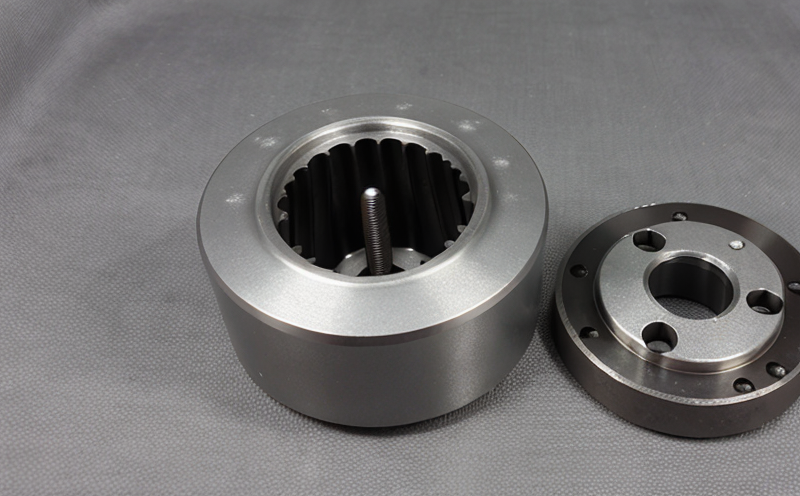ASTM E1461 Thermal Diffusivity of AM Materials by Laser Flash
The measurement of thermal diffusivity in additive manufacturing (AM) materials, as specified in ASTM E1461 using the laser flash method, is a critical step for ensuring that materials meet design specifications and performance requirements. This non-destructive test evaluates how quickly heat can propagate through a material, which is essential for predicting its thermal conductivity behavior under various operating conditions.
The laser flash technique involves shining an intense light pulse onto the surface of a specimen, followed by a rapid measurement of the temperature rise in response to this energy. This allows for the calculation of the thermal diffusivity using Fourier’s law and the Stefan-Boltzmann Law:
\[ D = \frac{k}{\rho c_p} \] where \(D\) is the thermal diffusivity, \(k\) is the thermal conductivity, \(\rho\) is the density of the material, and \(c_p\) is the specific heat capacity. Understanding these parameters is crucial for optimizing manufacturing processes and ensuring product performance.The ASTM E1461 method provides a standardized approach to testing, which ensures consistency across different laboratories. This standardization is particularly important in the rapidly evolving field of AM where material properties can vary significantly depending on the processing conditions such as laser power, scanning speed, and build orientation.
For powder metallurgy (PM) materials used in additive manufacturing, the ASTM E1461 test offers a reliable method to assess their thermal performance. The precision of this technique is especially valuable when dealing with AM processes that may introduce unique microstructural features not present in traditional PM materials. These microstructures can significantly affect thermal properties and thus influence the mechanical behavior of the final product.
The testing procedure involves several key steps, including specimen preparation, which typically requires uniformity in size and shape to ensure accurate results. The specimens are then mounted onto a holder that allows for precise positioning relative to the laser pulse. Once prepared, they undergo the laser flash measurement process, where multiple pulses may be required to achieve reliable data.
The resulting thermal diffusivity values provide insights into how heat is conducted through the material and can help in optimizing build parameters for specific applications. For instance, a higher thermal diffusivity could indicate better cooling rates during AM processes, which might lead to reduced residual stresses and improved microstructure formation.
Quality managers and R&D engineers benefit greatly from this test as it helps them make informed decisions about material selection and process optimization. Compliance officers can ensure that products meet regulatory requirements by verifying thermal properties against standards such as ASTM E1461. The test also aids in the development of new materials with enhanced thermal performance, which is crucial for applications like aerospace, automotive, and electronics industries.
- Consistent results across different testing environments
- Non-destructive nature allowing multiple measurements on the same specimen
- Ability to test small specimens typical of AM processes
- Compatibility with a wide range of materials including metals and alloys
Why Choose This Test
Selecting the ASTM E1461 method for measuring thermal diffusivity is advantageous due to its precision, repeatability, and adaptability. The laser flash technique provides a robust means of assessing material properties without causing damage, making it ideal for testing small or delicate specimens common in AM processes.
One of the primary reasons for choosing this test is its ability to provide consistent results across different laboratories. This standardization ensures that all measurements are comparable and reliable, which is essential for quality assurance and compliance purposes. The non-destructive nature of the method also allows for repeated testing, enabling researchers and engineers to refine their processes iteratively.
For R&D teams working on developing new AM materials or optimizing existing ones, ASTM E1461 offers a valuable tool for understanding how thermal properties vary with changes in processing parameters. This knowledge can lead to innovations that improve the efficiency and effectiveness of manufacturing processes. Additionally, compliance officers benefit from this test as it helps ensure that all products meet the stringent requirements set by international standards such as ISO 9001 or AS9100.
The adaptability of the ASTM E1461 method to various materials further enhances its utility across different sectors. From aerospace-grade titanium alloys used in high-performance aircraft components to nickel-based superalloys employed in turbine blades, this test can be applied effectively. The flexibility of the technique accommodates diverse material types and sizes, making it a versatile choice for any organization involved in AM.
By incorporating ASTM E1461 into their testing protocols, organizations can gain valuable insights into thermal properties that directly impact product performance. This information is crucial for optimizing manufacturing processes to ensure high-quality outputs consistently meet desired specifications.
Quality and Reliability Assurance
- Consistent Results: The ASTM E1461 method ensures that thermal diffusivity measurements are consistent across different laboratories, enhancing reliability in quality assurance processes.
- Non-Destructive Testing: By using a laser pulse to measure temperature changes, the test does not damage the specimen, allowing for multiple tests and iterative process improvements.
- Wide Material Compatibility: The technique can be applied to various materials used in AM processes, providing comprehensive data across different sectors.
- Precision and Accuracy: Standardized procedures ensure precise and accurate measurements, which are critical for meeting regulatory requirements and ensuring product quality.
Competitive Advantage and Market Impact
Incorporating ASTM E1461 thermal diffusivity testing into your quality control measures can provide significant competitive advantages. By ensuring that materials meet the highest standards, you not only enhance product performance but also build trust with customers who demand reliability from their suppliers.
Competitors who fail to adopt such advanced testing methods risk falling behind in terms of innovation and efficiency. With continuous advancements in AM technology, staying ahead requires rigorous quality assurance practices that include robust thermal property evaluations.
The ability to consistently produce high-quality products leads to better customer satisfaction and loyalty, ultimately driving market growth. Moreover, compliance with international standards like ASTM E1461 demonstrates a commitment to excellence that can attract new business opportunities globally.





